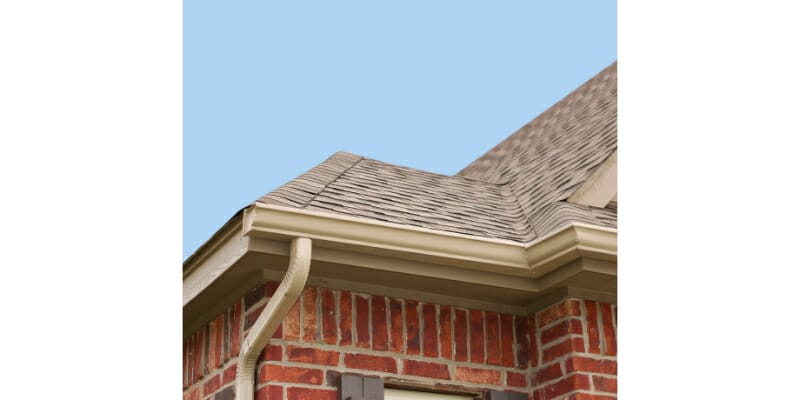Disclaimer: This post may contain affiliate links, meaning we get a small commission if you make a purchase through our links, at no cost to you. For more information, please visit our Disclaimer Page.
A downspout may seem like a boring thing, but it actually plays an important role in your home. It helps to divert rainwater from the gutters and send it away from your house.
The length a gutter can go with one downspout is dependent on several factors. The climatic conditions of your area will dictate how long the gutter can be. The surface area of the roof is also a primary factor. A standard length should be 30-40 feet.

The climatic condition plays a significant role in determining how long your gutter will run with one spout. An area with a high amount of rainfall will require that your gutter have several spouts at close intervals to drain off the water from the roof.
Spouts that are widely spaced on the gutter will have a high chance of making the gutter overflow and water drop next to the foundation of the building, which will then harm its foundation.
A dry region or areas that don’t receive a lot of rainfall do not need many spouts on the gutters. Since the amount of rain received in such locations is minimal, the spouts intervals on the gutter can belong.
Few spouts on the gutter will have the capacity to drain all the water from it effectively and will not require putting up many of them.
The size of your roof is also another critical determinant of how far apart your spouts should be placed. If you have a house with a large roof area, you will have to put up gutter spouts at short intervals.
A larger roof area will mean that the roof will collect a lot of water and drain it to the gutter in case of rain. Without good draining spouts from the gutters, you will experience flooded gutters, and the water will fall from your roof to the ground eliminating all the importance of having gutters in the first place.
Frequent water flowing close to the foundation of your house will also cause damages to the building.
Table of Contents
What Is The Maximum Length Of A Gutter?
To get the right size of the gutters, you first have to determine the roof size of your house or the building and the amount of rainfall commonly experienced in that area. Additionally, the roof’s slope will also determine how long your gutter should be.
All these factors will ensure that you have a perfect house that drains well when taken into consideration. You will eliminate all the problems that come with excess water falling off your roof during heavy downpours.
With that said, let us look at some of the factors that will affect the length of your gutter and tell you how long your drain should be for them to work perfectly.
A good size will also relieve the pressure of worrying that the gutter might collapse in case of heavy rains and a lot of water stays in the channel.
Aslope of the roofing
The slope of the roof will determine the length of the gutter. A roof with a high pitch can have a more extended chute as compared to gentle roofs. Steeper roofs will make the rainwater flow at a fast rate in the gutters. This will mean there won’t be much water stalling in the gutter, resulting in it sinking in.
Gutter size
The size of the gutter plays a more significant role in the length of the gutter. A more extensive channel can go for a longer length than a smaller gutter.
More oversized gutters can hold more water and can thus go for longer distances without requiring a spout to empty the water.
Amount of rainfall
The amount of rainfall received in an area will determine the length of the gutter. Small amounts of rainfall can allow you to have a long channel since there’s not much water collected in them.
The high quantity of rain, on the other hand, will restrict you to only having a short gutter. Erecting longer gutters in areas that receive high amounts of rainfall may risk them collapsing under the weight of the water that they hold.

How Long Can A Gutter Be With One Downspout?
When planning roof drainage systems, the size of the central gutters, downspouts, outlets, roof slope, and building type are all aspects to consider.
A suitable drainage system will keep your house in good condition for a long time and safeguard the building’s foundation.
The design capacity of a roof drainage system is determined by the amount of water to be carried. The amount of water held in gutters is determined by the roof area, slope, and rainfall intensity received in a particular region.
When examining the roof’s surface area, keep in mind that rain does not always fall vertically and that the best conditions occur when rain falls straight to a roof, which is an infrequent occurrence.
The gutter will never be effective if the spout outlet used to empty it is not well placed. Downspouts must not be larger than the width of the rain gutters at the bottom, as this will make the gutter ineffective and put off the entire look of the roof as well. The roof area grows as the pitch increases.
Thus the higher the pitch, the bigger the surface area. Using the plan area of a pitched roof to calculate a drainage system is not recommended. Using the actual size of a sloped roof generally leads to oversizing of rain gutter or gutters, downspouts, and drains, according to experience.
Here are some factors to consider when determining the length of your gutter and the type of downspout to install:
Roof area: The greater the roof surface above the gutters, the more rainwater will be gathered and directed down into the channels. Because a large roof will carry a lot of water, the downspout placements may need to be adjusted to accommodate. What this will mean is that a larger roof area will require more spouts. This will help get rid of the water faster than the roof is feeding it and will [prevent cases of overflowing.
Roof slope: A steeper slope flows water faster, and if gutters struggle to handle a large amount of water in a short period, an extra downspout can help.
You will hence be needed to take a closer consideration of the slope of your house roof. A steeper roof will mean water will flow at a faster speed and may overpower few spouts. If you have a steeper roof, consider having several spouts.
Gutter size: Gutters come in a variety of sizes. Larger gutters can store more water and will thus require fewer spouts. Smaller channels, on the other hand, may need additional downspouts to compensate for their limited capacity.
If you have a smaller gutter with a few spouts, you might experience the problem of them sinking in.
This is because the weight of water held in the drain accumulates and becomes too heavy for the gutter. This is because it’s not being emptied faster. You might also experience cases of overflowing in the trenches.
How Far Can You Run A Downspout?
If you have a building that has downspouts, you should consider extending them far from the foundation.
Downspouts are meant to empty water from the roof as far away as possible. Erecting your downspout so that it drains close to the house may cause damages to the building, especially if water frequently runs along the foundation. In regions with a high amount of rainfall, you might end up experiencing flooding.
Conclusion
A gutter plays a significant role when it comes to draining off rainwater from your roof. The length and size of the trench will primarily depend on the amount of rainfall received in the region.
The roofing surface areas will also dictate how large your gutter should be as they directly relate to the amount of water collected in them. Downspouts help make your roof drainage more efficient by emptying the gutters.
